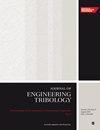研究纳米切削液环境对Ti6Al4V钛合金可加工性的影响
IF 1.8
3区 工程技术
Q3 ENGINEERING, MECHANICAL
Proceedings of the Institution of Mechanical Engineers, Part J: Journal of Engineering Tribology
Pub Date : 2023-07-19
DOI:10.1177/13506501231188358
引用次数: 0
摘要
本研究主要关注绿色加工,绿色加工是指在不损害环境和人体健康的情况下对零件进行环保加工。绿色加工是制造业的一种创新方法,旨在减少对环境的影响,并在整个加工过程中促进可持续发展。绿色加工包括机械加工、干式加工、高性能切削、混合加工和高速切削等方法的利用,以及环保润滑实践。本研究的目的是研究Ti6Al4V合金的加工效果,Ti6Al4V合金是一种在航空航天工业中广泛使用的轻质金属,以其具有挑战性的可加工性而闻名。该研究特别检查了在各种切削参数和摩擦学条件下的切削力、表面粗糙度和刀具磨损。研究了一种新的润滑/冷却方法的使用,以尽量减少在加工难加工材料时使用的传统切削液对环境和人体健康的影响。这样,在全球变暖和碳排放迅速增加的今天,实现了与环境相适应的可持续绿色生产。此外,观察到切削深度是决定切削力的因素,进给量是影响表面粗糙度的最显著因素。本文章由计算机程序翻译,如有差异,请以英文原文为准。
A green machining study to investigate the effect of nano-cutting fluid environments on the machinability of Ti6Al4V titanium alloy
This study primarily focuses on green machining, which refers to the environmentally friendly machining of parts without compromising the environment and human health. Green machining, an innovative approach in the manufacturing industry, aims to reduce the environmental impact and promote sustainable practices throughout the machining process. Green machining involves the utilization of methods such as machining, dry machining, high-performance cutting, hybrid machining, and high-speed cutting, along with environmentally friendly lubrication practices. The objective of this research is to investigate the effects of machining Ti6Al4V alloys, a widely used lightweight metal in the aerospace industry known for its challenging machinability. The study specifically examines cutting force, surface roughness, and tool wear under various cutting parameters and tribological conditions. The use of a new lubrication/cooling method was investigated in order to minimize the effects of traditional cutting fluids used in the machining of difficult materials, which may cause environmental and human health. This way, sustainable green production compatible with the environment has been realized today, where global warming and carbon emissions are rapidly increasing. In addition, it was observed that the factor determining the cutting force was the depth of cut and the feed rate was the most significant factor affecting the surface roughness.
求助全文
通过发布文献求助,成功后即可免费获取论文全文。
去求助
来源期刊

CiteScore
4.20
自引率
5.00%
发文量
110
审稿时长
6.1 months
期刊介绍:
The Journal of Engineering Tribology publishes high-quality, peer-reviewed papers from academia and industry worldwide on the engineering science associated with tribology and its applications.
"I am proud to say that I have been part of the tribology research community for almost 20 years. That community has always seemed to me to be highly active, progressive, and closely knit. The conferences are well attended and are characterised by a warmth and friendliness that transcends national boundaries. I see Part J as being an important part of that community, giving us an outlet to publish and promote our scholarly activities. I very much look forward to my term of office as editor of your Journal. I hope you will continue to submit papers, help out with reviewing, and most importantly to read and talk about the work you will find there." Professor Rob Dwyer-Joyce, Sheffield University, UK
This journal is a member of the Committee on Publication Ethics (COPE).
 求助内容:
求助内容: 应助结果提醒方式:
应助结果提醒方式:


